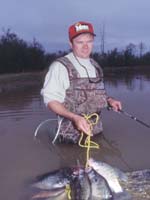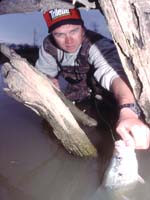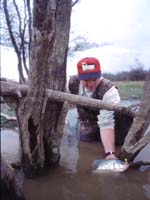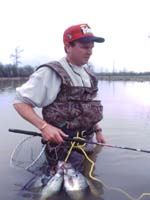
|
Features
|
|
|
|
Books
|
|
|
|
Fun & Games
|
|
|
|
Contact Us
|
|
|
Night Hawk Stories... Entry 32
The Crappie Dawg And The Pup
by John E.
Phillips
Page 3
The Pup
 Kent
Driscol who only has fished for crappie about 15 years, fishes the Crappie
U.S.A. tournament circuit and guides regularly on Arkabutla Lake. The
"Pup" practices a much more-aggressive and different style of crappie
fishing.
Kent
Driscol who only has fished for crappie about 15 years, fishes the Crappie
U.S.A. tournament circuit and guides regularly on Arkabutla Lake. The
"Pup" practices a much more-aggressive and different style of crappie
fishing.
Weldon can stay in his aluminum boat and get into the thick cover and catch plenty of crappie. He sees absolutely no reason at all to leave a perfectly good boat, put on a pair of waders and walk through the water to catch crappie when he can use his trolling motor and get to almost the same places.
But the Pup loves the adventure of getting to spots other people can't fish, finding cover other folks can't locate, and catching crappie for which most anglers will never have wet hooks. "I usually start wade-fishing the first of March and fish until the end of April in north Mississippi lakes," Driscol stated. "Because the spawn occurs at different times, I can usually use this wade-fishing tactic anytime that crappie are spawning, anywhere in the nation. When the crappie spawn is on, wade-fishing can't be beat for success."
Most people don't like to wade-fish for crappie, even though it often produces bigger crappie than boat-fishing does, because they don't like to get outside their boats and wade around on the bottom of a lake. Also, early spring means cool water. Fishermen run the risk of tripping and getting wet and cold.
 Driscol
starts to fish for crappie when the water temperature climbs to between
60 and 65 degrees. He has discovered that at this time of the year in
this water temperature, crappie will start spawning in ankle-high water.
"I fish in depths of 1 to 2 feet deep where I find trees and stumps in
shallow water," Driscol explained. "I look for spots where there's no
wind and no current because the water temperature is usually more stable
in these areas. Too, these kinds of places will usually be the first spots
crappie come in to spawn."
Driscol
starts to fish for crappie when the water temperature climbs to between
60 and 65 degrees. He has discovered that at this time of the year in
this water temperature, crappie will start spawning in ankle-high water.
"I fish in depths of 1 to 2 feet deep where I find trees and stumps in
shallow water," Driscol explained. "I look for spots where there's no
wind and no current because the water temperature is usually more stable
in these areas. Too, these kinds of places will usually be the first spots
crappie come in to spawn."
The Pup's Tackle
Driscol prefers virtually puncture-proof 5 mm Neoprene waders that keep his ankles and feet warm -- even in cold water. He chooses a 10-foot Sam Heaton B'n'M jigpole because it's ultra-sensitive, very light and has the backbone to wrestle big crappie away from thick brush.
"I like Trilene XT Solar line, which is a highly visible line," Driscol commented. "When I'm fishing in very thick cover, I'll often get a light bite. So, I need a highly visible line to see the least little tick on the line. I've learned that the sooner you can set the hook when you see the bite, the more likely you are to catch the crappie in thick cover."
 For
jig size, Driscol prefers either a 1/16- or a 1/8-ounce jig. "I usually
like a hard-bodied grub so the crappie can't tear the grub up as easily.
If the crappie will take it, I like to fish the 30-Second Teaser. The
30-Second Teaser is an odd-size jig made in Trenton, Tennessee, that measures
somewhere between a 1/16- and a 1/8- ounce jig. This jig also has a double-barbed
collar that helps hold the skirt on the jig. When I use this type jig,
I don't tear as many skirts in a day of fishing as when I fish with other
jigs."
For
jig size, Driscol prefers either a 1/16- or a 1/8-ounce jig. "I usually
like a hard-bodied grub so the crappie can't tear the grub up as easily.
If the crappie will take it, I like to fish the 30-Second Teaser. The
30-Second Teaser is an odd-size jig made in Trenton, Tennessee, that measures
somewhere between a 1/16- and a 1/8- ounce jig. This jig also has a double-barbed
collar that helps hold the skirt on the jig. When I use this type jig,
I don't tear as many skirts in a day of fishing as when I fish with other
jigs."
In stained water, Driscol prefers chartreuse-and-red, chartreuse-and-black, pink-and-black or chartreuse glow-colored jigs. In clear water, he'll use lighter-colored jigs. He also fishes with the Berkley Power Bait Crappie Nibbles and the Berkley MicroPower Wigglers.
"I've had very good luck catching crappie, especially under tough conditions, using the Nibbles and the Wigglers," Driscol reported. "I've fished in tournaments before where I couldn't catch any crappie, and then I'd put either Nibbles or Wigglers on the shank of my hook, and the crappie would begin to bite. I know the Power Bait Nibbles and Wigglers have made the difference in how I've finished in several crappie tournaments.
 "In
the 1999 Crappie U.S.A. Classic in Alabama, my partner and I had a limit
of 10 crappie that would have probably weighed about 8 pounds total. We
knew we had to change the color of our jigs to try to catch bigger crappie
if we hoped to place in the competition. Because the crappie fishing was
so bad, we tipped our jigs with minnows. Then we each cut MicroPower Wigglers
in half and put a small piece of the Wiggler on our hooks in front of
the minnows that were attached to our jigs. By using this technique, we
increased our stringer weight from 8 pounds to 11 1/2-pounds."
"In
the 1999 Crappie U.S.A. Classic in Alabama, my partner and I had a limit
of 10 crappie that would have probably weighed about 8 pounds total. We
knew we had to change the color of our jigs to try to catch bigger crappie
if we hoped to place in the competition. Because the crappie fishing was
so bad, we tipped our jigs with minnows. Then we each cut MicroPower Wigglers
in half and put a small piece of the Wiggler on our hooks in front of
the minnows that were attached to our jigs. By using this technique, we
increased our stringer weight from 8 pounds to 11 1/2-pounds."
Driscol always carries a dip net when he wades shallow water to catch big crappie. "I like the kind of dip nets that trout fishermen use that have bungee lines on the ends of the handles and clips on the end of the bungees," Discol advised. "Then I can clip the dip net onto my waders. When I need it, I simply take hold of the handle, stretch the dip net out to where the crappie is and pull it into the net. You'll land more crappie using a dip net when you're wade fishing then you will if you try to lift them.